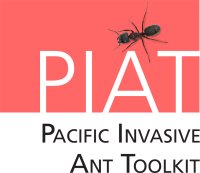Pharaoh ant
|
stings |
harms people |
lives on ground |
day active |
night active |
|
Scientific name: Monomorium pharaonis Size: about 2 mm Colour: uniform pale yellow to light yellow brown to red General description: the pharaoh ant is a small ant that forms conspicuous foraging trails indoors. It usually nests indoors and is mostly active at night Habitat and nesting: pharaoh ants do not build mounds or carve galleries in rotten wood, instead they form their nests in naturally occurring voids and crevices. Pharaoh ants frequently nest in houses and other manmade structures where they nest in wall cavities, behind baseboards, in refrigerator insulation, hollow curtain rods or in the folds of sheet, paper or clothes. Rate of spread: unknown. Distribution: see our invasive ant distributions page for the worldwide distribution of the pharaoh ant. Reproduction:new colonies are formed by budding. For detailed descriptions and identification of pharaoh ants: PIAkey: Monomorium pharaonis (see diagnostic characters tab) Social, agricultural and environmental impacts of the pharaoh antThe pharaoh ant is predominantly a social pest, as it usually nests indoors. This ant species is a serious pest in hospitals where it can vector human diseases. It also commonly nests in restaurants, grocery stores and people's homes. This ant is notorious for its ability to "get into things" (for example gnawing through food packages and infesting food). Where it has infested hospitals there have been reports of it attacking the eyelids of newborn babies. |
Pharaoh ant worker (© Alex Wild)
Pharaoh ants feeding on sugar water (© Quah, Termites and Ants of Malaysia)
Pharaoh ant worker (© AntWeb, Creative Commons Attribution, Share Alike CC BY-SA License) |
Information sources
AntWiki, Pharaoh ant
Centre for Agriculture and Bioscience International (CABI), Invasive Species Compendium, Pharaoh ant
Global Invasive Species Database (GISD)
Global Register of Introduced and Invasive Species (GRIIS)
Landcare Research Manaaki Whenua Ant Factsheet, Pharaoh ant
PIAkey, Pharaoh ant
Content reviewed by Eli Sarnat, Antwork Consulting, LLC, June 2017



